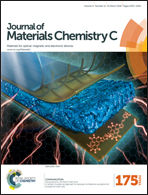Amine vapor responsive lanthanide complex entrapment: control of the ligand-to-metal and metal-to-metal energy transfer†
Abstract
The encapsulation of luminescent species into microporous materials has provided a powerful luminescent platform for probing volatile organic molecules (VOMs). Most of the studies reported so far, however, have been based only on the luminescence intensity of one transition, which is seriously impacted by the concentration of the sensor, excitation power, and the drifts of the optoelectronic systems such as lamps. To address this issue, we herein develop a luminescent platform based on the entrapment of Eu3+ and Tb3+ co-doped lanthanide complexes within nanozeolite L (NZL) channels. Such a luminescence sensor achieves fast responses with amine solvents, representing the unambiguous identification of amine solvents. Moreover, each of the amine solvents (with larger pKa values) has a unique characteristic readout of IEu/ITb, which makes an excellent fingerprint correlation between the amine solvents (with larger pKa values) and emission intensity ratio (IEu/ITb) be achieved. This approach should be a very promising strategy for developing luminescent materials with potential practical applications, which has various desirable advantages like simple and easily scalable preparation, cost-effectiveness, and self-calibration.


 Please wait while we load your content...
Please wait while we load your content...